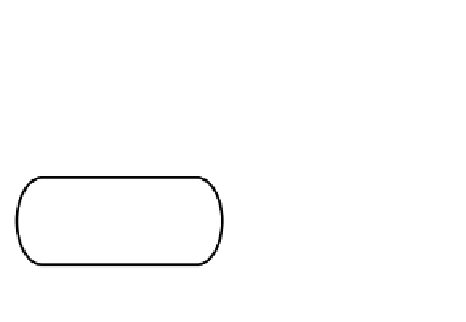Biomedical Engineering Reference
In-Depth Information
Holding V
m
e
V
m
V
h
i
e=V
m
-V
h
I
in
=Re
Axon
Figure 3.3:
Voltage clamp circuit.
If the circuit can react faster than the membrane, an exactly counterbalancing current,
I
in
, may be sent
into the cell to maintain a specific voltage level. The transient of this counterbalancing current can be
used to determine how fast the membrane can react to changes when
V
m
=
V
h
, while the steady-state
current can be used to determine the maximum current at the clamped
V
m
. The combination of these
two parameters, reaction time and maximum current, as a function of
V
h
, enabled Hodgkin and Huxley
to develop the first mathematical model of an excitable cell.
It is clear from Fig. 3.3 that at least one electrode must have access to the inside of a cell. At the
time of Hodgkin and Huxley, electrodes were relatively large compared to mammalian neurons.To create
their model, Hodgkin and Huxley chose to study the large axon (up to 1
mm
in diameter) of the giant
squid. Since 1952, the size of electrodes has drastically shrunk, allowing for many types of neurons to be
studies. The electronic feedback loop of the voltage clamp, however, has remained largely unchanged.
3.1.4 The SodiumCurrent
The Sodium current is formulated in the same way as the leakage current.
I
Na
=
G
Na
(V
m
)
[
V
m
−
E
Na
]
(3.4)
but now the leakage term
G
Na
is a nonlinear function of
V
m
. To begin, Hodgkin and Huxley assumed
(again correctly) that the nonlinear nature of the flow of Sodium ions was due to the opening and
closing of proteins that spanned the membrane. These proteins could somehow change their shape to
be either open or closed in response to pH, intra and extracellular concentrations of ions and molecules,
temperature, or even
V
m
.Hodgkin andHuxley focused on the impact of changes in the membrane voltage.
Yet another assumption was that each ion channel would be either entirely open or entirely closed. In
other words, there would be no in between states.To create their model, however, they assumed that there
were thousands or millions of Sodium channels embedded in a small patch of membrane. Therefore, the
model would be based on the
probability
that any individual channel would be open. So, although each
ion channel would be either open or closed, 30% of the channels may be open and 70% are closed. To
capture the aggregate behavior, Hodgkin and Huxley defined a variable,
O
, that would be 0.3, or the




















